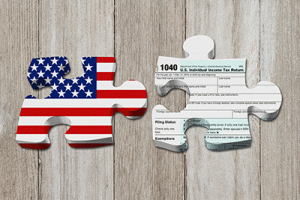TAKING CARE OF YOUR TAXES, even if your financial situation was a relatively simple one where all of your earning can from a traditional employer, used to mean pulling out your calculator, pencil and working on paper forms. It also meant that you had to understand a little bit about tax law, or at the very least, be able to read those crazy forms put out by the IRS. If your financial situation was more complex, like being an independent contractor or a small business owner, the process only got more difficult.
Today, tax preparation software makes it much easier to ensure that you’re doing everything right. Instead of filling out forms, these systems typically ask you questions to help you file, filling in the forms correctly as you go. They’re also considerably faster since your tax return can be filed electronically as soon as you finish, which can help you get your return faster if you’re expecting one.
The History Of Tax Software
The history of being able to file your taxes electronically started around 1986, and while major private companies are now part of the game, it was actually a government agency that started the first program. Limited to just a few tax preparers in a handful of cities, it was years before it became commonplace.
In the late 1980s and early 1990s, private companies began to pop up on the market and start to offer a simpler way to file taxes. Since the mid-1990s, those services have caught on and more and more people have been using them since.
Today, approximately 90-percent of people who file a tax return will do so electronically according to the INTERNAL REVENUE SERVICE. Many of them will use either free or paid tax software from private companies.

Tax Software vs. CPA Services
Going to a CPA or certified public accountant is certainly one way to get your taxes done. Many companies even offer these services at relatively low rates during tax time since most people’s taxes are quite easy for accountants familiar with tax codes. In most cases though, tax software is considerably cheaper than hiring a CPA.
What makes tax software different is that you can be in charge of your taxes and typically finish them in less time. This can help you maximize the turnaround time on your refund if you plan to file early for this reason.
For individuals with complicated taxes, a CPA may be helpful in ways that tax software is not. For example, you may have deductions that you are not aware of. Your tax software will have a way to enter deductions, but it won’t necessarily help you find them to avoid a large tax bill.
E-Filling vs. Filing On Paper
Filing on paper is the old method that people used to use every single year. Today, E-FILING IS MUCH MORE COMMON and almost everyone does it. The main reason is speed and the fact that you don’t have to deal with difficult tax forms.
With online tax preparation software, you’ll be answering questions to get your answers and your forms will be auto-filled for you. On paper, you’ll need to understand the forms, the added sidebar information and make sure all of your numbers are correct without any virtual assistance.
E-filing is also much faster since you don’t have to print and mail actual paper. That means you’ll be getting your return faster.
Tax Software: Is It Easy To Use?
Tax software is DESIGNED TO BE EASY TO USE. In most cases, tax software was actually designed to make the process easier since filing on paper can be somewhat tricky. Just look at a standard tax form on paper and your head might start to spin!
Of course, different brands of tax software may be easier for you to grasp and use, so you’ll need to choose the option that’s right for you. For most average users with minimal deductions and expenses, almost any tax preparation software is completely functional and much faster than working on paper.
What Features Are Offered With Tax Software?
When choosing a particular type of tax software, you’ll want to make sure you’re getting features that fit your needs. Here are a few common features to look for to help you handle your taxes quickly and correctly:
• A free version for individuals making under a certain dollar amount each year. For many programs, this cut-off point is around $65,000.
• A version of the program for small business owners, independent contractors, and sole proprietors. You’ll need to file separate forms like a schedule C, which can be confusing. Get the right version of software to make sure you file correctly.
• A refund calculator or estimator. For many people, knowing what they’ll get back is essential to plan for home repairs or simply adding to their savings. Look for a program that offers a refund calculator if you typically get a refund each year.
• State filing. Filing your state taxes is something that you’ll still need to do along with your federal return. Look for a program that will take care of both based on your federal filing information. Some programs even offer this service for free or for a very minimal additional filing fee.
Ready to tackle your taxes this year? Using online tax preparation software is often an ideal choice. Just make sure you evaluate your options before you sign up with any service. Some providers may have a better program for your individual or small business needs.
Advertising Disclosure: This post contains affiliate links and at no additional cost to you, Watch the Review will be compensated if you make a purchase after clicking on these links.
